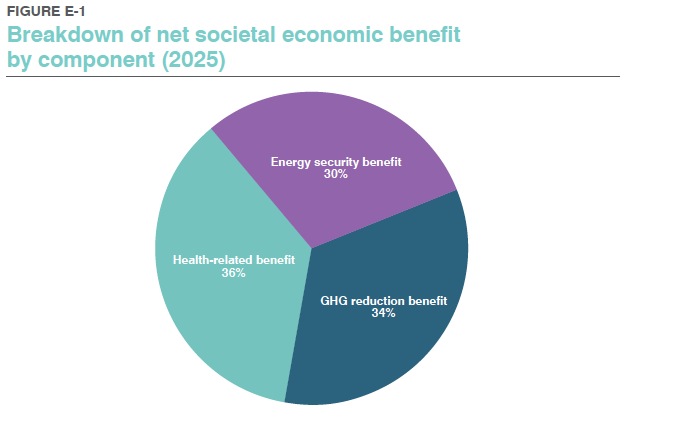ENVIRONMENTAL DEFENSE FUND
AMERICAN LUNG ASSOCIATION IN CALIFORNIA
Driving California Forward: Public Health and Societal Economic Benefits of California’s AB 32 Transportation Fuel Policies
Executive Summary
The transportation sector is the largest source of pollution in California, contributing close to 70% of smog-forming gases and 40% of the state’s climate change pollution every year. Consequently, the current transportation system is responsible for a significant portion of the adverse health impacts that citizens suffer from, in addition to causing energy vulnerability that threatens economic stability and contributing to climate change that threatens the future of our state and planet.
California can reduce these severe negative impacts by cutting the overall system’s rate of pollution that endangers public health (e.g. NOx, SOx, and PM2.5), growing the volume of domestically produced clean fuels, and cutting carbon pollution from fuels. Among the many policies being pursued to drive this transformation are the state’s AB 32 Low Carbon Fuel Standard (LCFS) and cap-and-trade regulation (C&T).
This analysis calculates the economic benefit of the LCFS and C&T by evaluating the societal benefits of full implementation in 2020 and 2025, which include 1) avoided public health costs and incidents of illness, 2) avoided fossil fuel dependence costs, and 3) avoided climate change-related costs (see Figure E-1 below for the proportion of the total societal economic benefit attributed to these three components). These benefits are compared to a baseline that does not factor in those policies to show that by 2025, the LCFS and C&T will incentivize the shift to a cleaner transportation fleet that will save the state and its citizens money.
Combined benefits of LCFS and C&T fuel regulations
Modeling conducted for this report shows that without the LCFS and C&T, the California transportation system is expected to result in cumulative societal economic impacts of $274 billion by 2020 and $387 billion by 2025. The transition to a cleaner and more diverse vehicle fleet will require investments in alternative fuel production and infrastructure. According to modeling conducted in this analysis, the LCFS and C&T regulations will result in cumulative benefits from avoided health, energy insecurity, and climate change costs of $10.4 billion by 2020 and $23.1 billion by 2025. The model used in this report includes benefits from both the light‑duty (e.g. passenger cars and light trucks) and heavy-duty (e.g. on- and off-road trucks and buses) sectors. Each of the three components studied in this report are described in further detail below.
Health effects of the current transportation system and benefits of new fuel regulations
Among the many documented impacts of air pollution generated from cars and trucks is increased risk of asthma attacks, heart attacks, cardiovascular disease, respiratory ailments, and cancer, as well as shortened lifespan. This pollution is particularly detrimental to more vulnerable populations, such as infants, children, and the elderly; low-income and disadvantaged individuals who are already exposed to increased amounts of pollutants; and people with pre-existing lung and heart diseases. All told, air pollution has been estimated by the California Air Resources Board to cause 9,200 deaths in California per year,1 with more recent research indicating that approximately 21,000 deaths per year in California are caused by roadway pollution.
A 2011 American Lung Association in California report entitled The Road to Clean Air, which this report builds on, demonstrates that a reduction in transportation pollution from increasing cleaner and more efficient passenger vehicles will improve the quality of the air and reduce the incidence of observed health impacts. This transition will not only directly improve health, but also create billions of dollars in annual economic benefits in the form of fewer missed work days and fewer expensive hospital visits.
Pursuant to the analysis presented in this report, the increased use of cleaner fuels through implementation of the LCFS and C&T program will substantially improve air quality and reduce climate pollution generated in California leading up to 2020 and beyond. By 2025, when a significant part of the vehicle and fuel mix will have been influenced by the LCFS and C&T, communities can expect a cumulative benefit from the LCFS and C&T that includes:
- Savings of $8.3 billion in pollution-related health costs
- Prevention of 600 heart attacks and 880 premature deaths caused by air pollution
- Prevention of 38,000 asthma attacks and almost 75,000 lost work days
- Reduction of criteria pollutant emissions by almost 180,000 tons
Download full version (PDF): Driving California Forward
About the Environmental Defense Fund
www.edf.org
Environmental Defense Fund is dedicated to protecting the environmental rights of all people, including the right to clean air, clean water, healthy food and flourishing ecosystems. Guided by science, we work to create practical solutions that win lasting political, economic and social support because they are nonpartisan, cost-effective and fair.
About the American Lung Association in California
www.lung.org/associations/states/california
The American Lung Association in California saves lives and improves the health of Californians and their lungs. Through research, education and advocacy, we fight to reduce smoking, keep the air we breathe clean, prevent and treat lung diseases such as asthma and chronic obstructive pulmonary disease, and eliminate lung cancer.
Tags: AB 32, American Lung Association in California, CA, California, Environmental Defense Fund, Fuel







 RSS Feed
RSS Feed